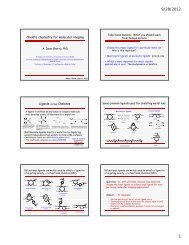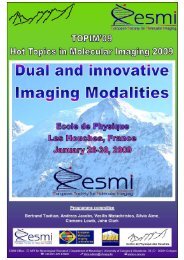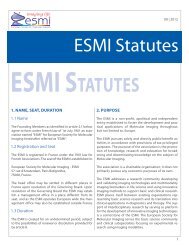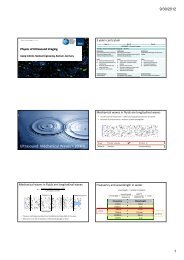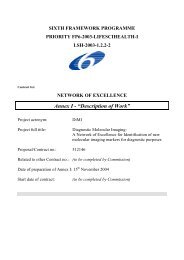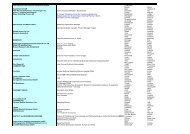5th EuropEan MolEcular IMagIng MEEtIng - ESMI
5th EuropEan MolEcular IMagIng MEEtIng - ESMI
5th EuropEan MolEcular IMagIng MEEtIng - ESMI
You also want an ePaper? Increase the reach of your titles
YUMPU automatically turns print PDFs into web optimized ePapers that Google loves.
182<br />
WarSaW, poland May 26 – 29, 2010<br />
P-069 Pyridine-based lanthanide complexes : towards bimodal agents operating as near infrared<br />
luminescent and MRI reporters<br />
Toth E. (1) , Bonnet C. (1) , Villette S. (1) , Suzenet F. (2) , Buron F. (2) , Shade C. (3) , Petoud S. (1) .<br />
(1) Centre de Biophysique Moléculaire, CNRS, Orleans, France<br />
(2) Université d’Orléans, France<br />
(3) University of Pittsburgh, USA<br />
eva.jakabtoth@cnrs-orleans.fr<br />
Introduction: Among the state of the art bioimaging<br />
modalities, some are characterized by high<br />
resolution but low sensitivity (magnetic resonance<br />
imaging, MRI) and others by high sensitivity but<br />
low macroscopic resolution (optical imaging). Luminescent/MRI<br />
bimodal imaging offers the advantage<br />
of combining the high resolution of MRI<br />
with the high sensitivity of luminescence and the<br />
development of contrast agents active for both<br />
techniques is of prime importance. Lanthanides<br />
offer unique opportunity to develop such bimodal<br />
contrast agents given their magnetic and optical<br />
properties. Nevertheless, it was long thought that<br />
the conditions required for both applications were<br />
non-compatible. Here, we report on a versatile pyridine-based<br />
scaffold for Ln 3+ complexation where<br />
MRI and near infrared (NIR) luminescence requirements<br />
are both satisfied using the same ligand.<br />
Methods: The synthesis of the ligands and the complexes<br />
will be briefly described. Potentiometric<br />
titrations have been performed to assess to thermodynamic<br />
stability of the complexes, together<br />
with kinetic measurements to quantify their inertness.<br />
To characterize the MRI properties, the exchange<br />
rate of the water molecules directly bound<br />
the Gd 3+ was determined by measuring 17 O longitudinal<br />
relaxation times. Finally the NIR spectra<br />
of the corresponding Nd 3+ and Yb 3+ were recorded,<br />
as well as the lifetimes of the excited states and the<br />
quantum yield of the complexes to quantify their<br />
luminescent properties.<br />
Results: The bishydrated complexes are found to be<br />
thermodynamically stable and the ligands show a significant<br />
selectivity for Ln 3+ over endogenous cations<br />
such as Zn 2+ , Ca 2+ and Cu 2+ . The kinetic inertness is<br />
also remarkable for such bishydrated complexes. The<br />
chelates do not form ternary complexes with endogenous<br />
donors which does not limit relaxivity in biological<br />
media. All the complexes give rise to NIR emission<br />
and the quantum yields are remarkable. 1 They are in<br />
the same range as those of non-hydrated complexes optimized<br />
for fully protecting the NIR emitting Ln 3+ for<br />
aqueous applications. The modification of the pyridine<br />
into quinoline was successful in shifting the excitation<br />
wavelength of the system towards higher values.<br />
imaging life<br />
Conclusions: The pyridine synthon is a prime candidate<br />
for the development of bimodal NIR/MRI imaging<br />
probes, as the bishydrated Ln 3+ complexes are thermodynamically<br />
and kinetically stable and display a high<br />
NIR quantum yield. The successful modification of the<br />
pyridine into a quinoline did not modify the thermodynamic<br />
properties of the complexes, but it resulted<br />
in a shift of the excitation energy towards lower values<br />
preventing damages to biological samples and allowing<br />
deeper tissue penetration of the excitation photons. The<br />
pyridine platform offers also easy routes for coupling<br />
the probes to biological vectors and optimizing the<br />
MRI properties.<br />
Acknowledgement: This work was financially supported<br />
by the Institut National du Cancer, La Ligue contre<br />
le Cancer, France, and was carried out in the frame of<br />
the COST action D38.<br />
References:<br />
1. L. Pellegatti, J. Zhang, B. Drahos, S. Villette, F. Suzenet,<br />
G. Guillaumet, S. Petoud, E. Toth, Chem. Commun.,<br />
2008, 6591-6593.<br />
2. S. Comby, D. Imbert, C. Vandevyver, J.-C. G. Bünzli,<br />
Chem. Eur. J., 2007, 13, 936.



